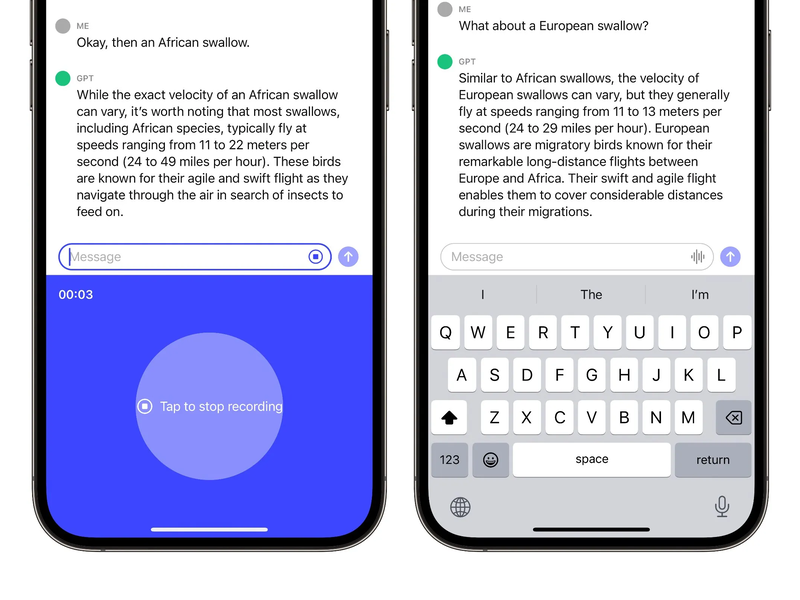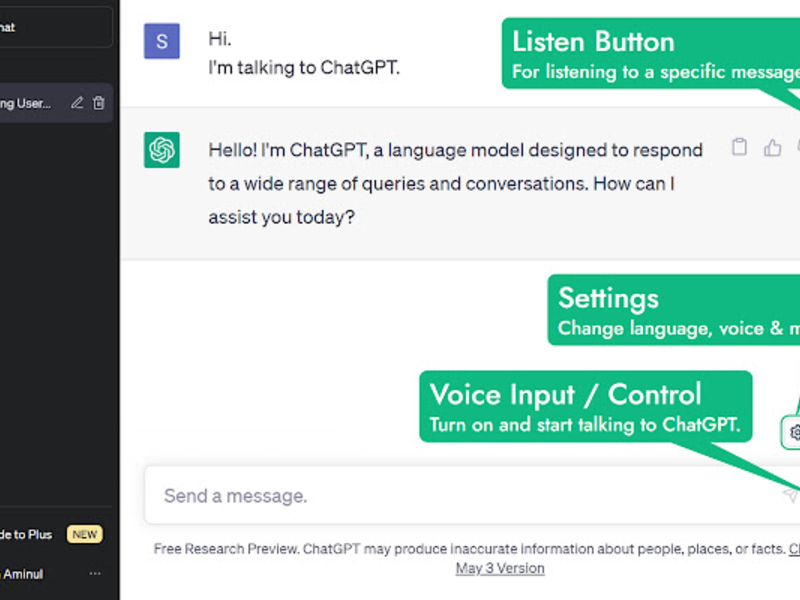How to Use ChatGPT Voice Control - Complete Tutorial
Published on
ChatGPT, a brainchild of OpenAI, has been a game-changer in the realm of conversational AI. But what if we told you that typing out your queries is now a thing of the past? Enter Voice Control for ChatGPT - a feature that's set to redefine our interactions with this powerful AI. Imagine having a casual chat with your AI buddy, only this time, you're speaking, and it's responding back, almost like a real human. Sounds intriguing? Let's dive in!
In today's fast-paced world, the convenience of voice commands is undeniable. Whether you're driving, cooking, or just too lazy to type, voice control comes to the rescue. And with ChatGPT's latest voice control features, the future of AI interactions looks brighter than ever.
Check Out the ChatGPT Cheatsheet!
Get to know the capabilities, tips, and tricks to maximize your experience with ChatGPT. Dive in now! Explore the Cheatsheet
OpenAI's Revolutionary Update: 2024-04-30 Enhanced Capabilities

ChatGPT's Vision and Voice Interactions
OpenAI has been at the forefront of AI innovations, and their recent update to ChatGPT is nothing short of revolutionary. The AI can now see, hear, and speak. Yep, you read that right! It's like giving eyes and ears to your virtual buddy. This is powered by a state-of-the-art text-to-speech model, which can generate human-like audio from text. And guess what? OpenAI has even collaborated with professional voice actors to offer a diverse range of voice options. Diversity and inclusivity? Check!
But that's not all. The image capability is another feather in ChatGPT's cap. Show it an image, and it can provide insights. Be it a complex graph, a picture of your fridge, or even a meme, ChatGPT is now equipped to "see" and understand. This is all thanks to the multimodal versions of GPT, which combine the prowess of language reasoning with image understanding.
ChatGPT can now see, hear, and speak. Rolling out over next two weeks, Plus users will be able to have voice conversations with ChatGPT (iOS & Android) and to include images in conversations (all platforms). https://t.co/uNZjgbR5Bm (opens in a new tab) pic.twitter.com/paG0hMshXb
— OpenAI (@OpenAI) September 25, 2023
Safety Measures and Gradual Deployment
With great power comes great responsibility. OpenAI is well aware of the potential risks that come with such advancements. Realistic synthetic voices could be misused for impersonation or even fraud. But fret not! OpenAI is taking a cautious approach. They're rolling out these features gradually, starting with Plus and Enterprise users. The idea is to gather feedback and refine the system, ensuring it's both useful and safe. So, while the future looks promising, it's also secure.
ChatGPT's Official Mobile Presence: The iPhone App
Features and Functionality of the ChatGPT iPhone App
Hold onto your hats, folks! ChatGPT has officially landed on iPhones. With the launch of the official mobile app, interacting with ChatGPT on the go has never been easier. And the best part? The voice input is powered by Whisper AI, ensuring seamless voice-to-text conversions. Whether you're commuting, waiting in a queue, or just lounging on your couch, ChatGPT is now just a tap away.

The app isn't just a replica of the ChatGPT website. It's been designed keeping mobile users in mind. The interface is intuitive, the response time is snappy, and the overall experience is top-notch. And for all the Android users out there, there's some good news. An Android version of the app is in the works and will be launching soon. So, stay tuned!
The Mechanics of Voice Control for ChatGPT
How does it work?
Voice control isn't just about recognizing what you're saying; it's about understanding and responding appropriately. When you speak to ChatGPT, your voice is converted into text using advanced voice recognition systems. This text is then processed by ChatGPT, which crafts a suitable response. But here's the magic: instead of just displaying the text, ChatGPT can now vocalize its response, making the interaction feel more like a conversation with a human.
The Chrome extension for ChatGPT (opens in a new tab) is a prime example of this in action.

Once installed, it allows users to interact with ChatGPT vocally right from their browser. And for the developers out there, there's a Python code available on GitHub that interfaces with ChatGPT using speech recognition and text-to-speech libraries. It's a DIY solution for those who love to tinker!
Benefits of Using Voice Control with ChatGPT
Enhancing User Experience
Remember the days when you had to type out every single query? Those days are long gone. With voice control, interacting with ChatGPT feels more natural and engaging. It's not just about convenience; it's about making AI interactions more human-like. And if you're curious to see it in action, there's a video (opens in a new tab) that showcases the extensions and their capabilities. It's a glimpse into the future of AI interactions.
Voice Control for Multilingual Conversations
Language Learning with ChatGPT
Language learners, rejoice! ChatGPT's voice control is a boon for those looking to practice pronunciation and comprehension. Imagine having a conversation in Spanish, French, or any other language, and getting instant vocal feedback. It's like having a language partner available 24/7. And with ChatGPT's vast knowledge base, you can dive deep into cultural nuances, idioms, and colloquialisms, making your learning experience rich and immersive.
Conclusion
Voice Control for ChatGPT is more than just a feature; it's a leap towards making AI interactions more human-centric. Whether you're a language learner, a developer, or just someone curious about AI, the voice control capabilities of ChatGPT offer a glimpse into the future of human-AI interactions. With OpenAI's continuous innovations and the ever-growing ecosystem of extensions and apps, the future looks promising. So, why wait? Dive into the world of vocal AI interactions and experience the magic firsthand!
Check Out the ChatGPT Cheatsheet!
Get to know the capabilities, tips, and tricks to maximize your experience with ChatGPT. Dive in now! Explore the Cheatsheet
Frequently Asked Questions
Q: Can you use ChatGPT with voice?
A: Absolutely! With the latest updates and extensions, you can now interact with ChatGPT using voice commands, making the experience more intuitive and engaging.
Q: How do I use ChatGPT as a voice assistant?
A: By installing the Chrome extension or the mobile app, you can use ChatGPT as a voice assistant. Just speak your query, and ChatGPT will respond vocally.
Q: How do I turn on voice typing for texting?
A: On the ChatGPT mobile app, there's a microphone icon. Tapping on it activates voice typing, allowing you to speak your message instead of typing it.
Q: How do I voice chat with ChatGPT on Android?
A: An Android version of the ChatGPT app is in the works. Once launched, it will support voice interactions, allowing users to have vocal conversations with ChatGPT.
Q: What is voice control for ChatGPT Chrome extension for Android?
A: The voice control feature for the ChatGPT Chrome extension allows users to interact with ChatGPT vocally from their browser. While primarily designed for desktops, there are plans to optimize it for Android browsers in the future.
